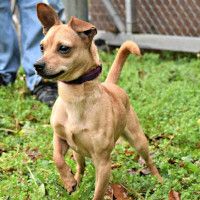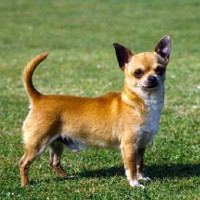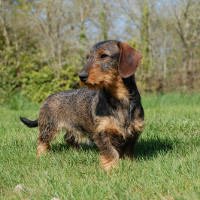Appearance of the Chiweenie
|
| Chiweenies tend to have the body of their Dachshund parent and long legs. Their coat can be long or short, silky or rough, solid color or a combination of the following: white, red, brown, black. If the Dachshund parent is a miniature, his Chiweenie offspring will of course be smaller than those of classic Dachshunds, but on the whole, Chiweenies are small dogs, 20 to 25 centimeters in height and weighing between 3.5 and 5.5 kilos. They have floppy ears that stand erect when alert, pointing outwards like bat wings. The nose can be short or pointed, black or brown, the tail is generally long and curved, they have small paws and almond-shaped eyes (black, brown or green). |
Temperament of the Chiweenie
|
Chiweenies are affectionate and caring, always attentive to their environment and staying as close as possible to their owners. They are loyal and protective of their family, and tend to choose one family member over others, with whom they develop a stronger bond. These dogs are therefore a good choice for single people, but also the elderly and families with children. However, they are not the best pets for young children, as Chiweenies are easily annoyed by excessive activity or noise, and don't necessarily tolerate the turbulence associated with small children. In addition, they have sensitive backs, due to their long bodies, and fragile paws, so a certain level of awareness is advised when playing and interacting with Chiweenies.
Despite their sensitive nature, Chiweenies are generally laid-back and very friendly. They love to play and run around, but also to snuggle up on the sofa, making them a coveted pet with which to interact in a lively and fun way, but which can also be comfortably seated on your lap. Chiweenies like to be the center of attention and can become jealous. So they tend not to get on well with other animals. Raising a Chiweenie alongside other dogs or cats as a puppy will solve this problem, as they will get used to other animals from an early age.
Chiweenies are good watchdogs because they're alert and tend to bark, just like their Dachshund parent, a hunting dog. Chihuahuas are also renowned for their high-pitched voice and loud sound, so it's the perfect combination for a cute dog who loves to express himself. In any case, they're sociable dogs who like to be around people. They are attached to their families and can suffer from separation anxiety. They can also be aggressive towards other dogs. Socialization and training are therefore essential to raising well-tempered dogs. |
Needs and activities of the Chiweenie
|
| The Chiweenie needs plenty of activity to get rid of its accumulated energy. If your furry companion doesn't get enough exercise, he'll get bored and this will cause behavioral problems such as chewing and barking. Try to give your dog at least 30 to 60 minutes of vigorous exercise every day, such as a hike, a swim, a trip to the local dog park, a walk or run around the neighborhood, or a long game of fetch. They also enjoy agility training and can be very good at it. Chiweenies can become obese if they don't get enough physical activity every day. |
Maintenance of the Chiweenie
|
| Chiweenie care depends on the coat type of the parent breeds. Short-haired Chiweenies are easy to care for, requiring only a stiff bristle brush two or three times a week. Long-haired Chiweenies need to be brushed more often, and you may also need to use a metal comb to avoid tangles. The wire-haired version of this dog should be groomed at least once every six months. You can do this yourself by removing the outer coat with a stripping knife or by a professional. You should also check their ears once a week and trim their nails if necessary. In addition, take care of their teeth by brushing them several times a week, as small dogs are prone to dental disease. |









 English (United Kingdom)
English (United Kingdom)